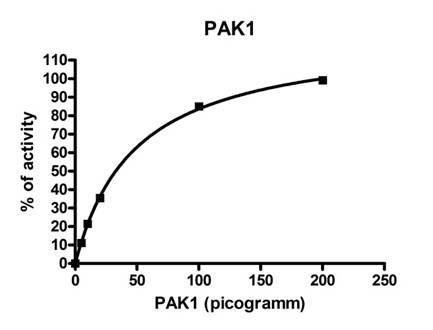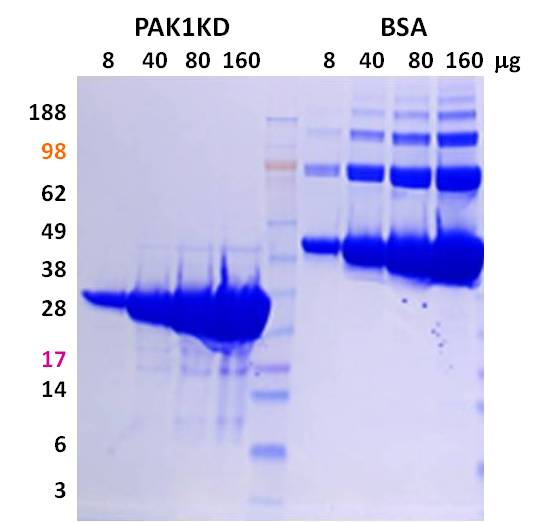PAK1KD(recombinant human PAK1 kinase domain)
본문
PAK1KD(recombinant human PAK1 kinase domain)
A. Product detail
1. Description :
Human PAK1 kinase (UniProt: Q13153; NCBI: NM_002576) belongs to a family of p21-activated kinases. These serine/
threonine kinases serve as targets for the small GTP binding proteins Cdc42 and Rac and have been implicated in a wide
range of biological activities. PAK1 kinase regulates cell motility and morphology.
PAK1KD is a recombinant wild type human PAK1 kinase domain (amino acids 248–545 of full-length human PAK1)
PAK1KD is a recombinant wild type human PAK1 kinase domain (amino acids 248–545 of full-length human PAK1)
expressed in E. coli and purified to near homogeneity. PAK1KD does not have the inhibitory switch domain and has high
specific activity.
2. Molecular Mass and Phosphorylation :
The calculated mass is 33,646. PAK1KD is fully phosphorylated at T423 and partially phosphorylated at additional sites
2. Molecular Mass and Phosphorylation :
The calculated mass is 33,646. PAK1KD is fully phosphorylated at T423 and partially phosphorylated at additional sites
with measured mass of 33,728 (1P), 33,808 (2P), 33,889 (3P), and 33,968 (4P).
3. Applications :
Useful for studies of enzyme kinetics, screening inhibitors, and selectivity profiling
Crystallization grade also available.
4. Stability and Storage :
Stable at -70℃ for 12 month from date of receipt. Protein should be thawed on ice. Protein can be flash-frozen in liquid nitrogen and stored at -70℃.
3. Applications :
Useful for studies of enzyme kinetics, screening inhibitors, and selectivity profiling
Crystallization grade also available.
4. Stability and Storage :
Stable at -70℃ for 12 month from date of receipt. Protein should be thawed on ice. Protein can be flash-frozen in liquid nitrogen and stored at -70℃.
B. Data sheet
1. Sequence :
GPHPSDEEILEKLRSIVSVGDPKKKYTRFEKIGQGASGTVYTAMDVATGQEVAIKQMNLQQQPKKELIINEILVMREN
KNPNIVNYLDSYLVGDELWVVMEYLAGGSLTDVVTETCMDEGQIAAVCRECLQALEFLHSNQVIHRDIKSDNILLGM
DGSVKLTDFGFCAQITPEQSKRSTMVGTPYWMAPEVVTRKAYGPKVDIWSLGIMAIEMIEGEPPYLNENPLRALYLIA
TNGTPELQNPEKLSAIFRDFLNRCLEMDVEKRGSAKELLQHQFLKIAKPLSSLTPLIAAAKEATKNNH
GPHPSDEEILEKLRSIVSVGDPKKKYTRFEKIGQGASGTVYTAMDVATGQEVAIKQMNLQQQPKKELIINEILVMREN
KNPNIVNYLDSYLVGDELWVVMEYLAGGSLTDVVTETCMDEGQIAAVCRECLQALEFLHSNQVIHRDIKSDNILLGM
DGSVKLTDFGFCAQITPEQSKRSTMVGTPYWMAPEVVTRKAYGPKVDIWSLGIMAIEMIEGEPPYLNENPLRALYLIA
TNGTPELQNPEKLSAIFRDFLNRCLEMDVEKRGSAKELLQHQFLKIAKPLSSLTPLIAAAKEATKNNH
- The first 4 residues GPHP are from Turbo3C cleavage site.
- Phosphorylated at T423.
2. Component and Formulation :
PAK1KD: 1 mg/ml in Storage Buffer of 25 mM Tris-HCl pH8.0, 150 mM NaCl, 10% glycerol, 5 mM DTT.
3. Activity :
Specific activity: 32,638 pmoles/min/µg
>
- Phosphorylated at T423.
2. Component and Formulation :
PAK1KD: 1 mg/ml in Storage Buffer of 25 mM Tris-HCl pH8.0, 150 mM NaCl, 10% glycerol, 5 mM DTT.
3. Activity :
Specific activity: 32,638 pmoles/min/µg
>

Analysis of enzymatic activity was performed according to Zlyte assay protocol (Invitrogen):
- Different concentration of PAK1KD were incubated in a buffer containing 50 mM HEPES (pH7.5), 10 mM MgCl2, 1 mM EGTA, 200 mM ATP, 0.01% Brij-35, and 2 µM substrate (SER/THR 14, Invitrogen) at room temperature for 1 hour.
- Developer solution was added to reaction and reaction was stopped after 1h of incubation at RT.
- Fluorescence was detected using lexc=460±40 nm and lem=528±20 nm filters.
4. SDS-PAGE Analysis :


Ordering information ;
1. 10 µg
2. 100 µg
3. 1 mg
4. Bulk 단위로도 공급이 가능합니다.(별도로 문의 바랍니다)
2. 100 µg
3. 1 mg
4. Bulk 단위로도 공급이 가능합니다.(별도로 문의 바랍니다)
* Concentration : 1 mg/ml
댓글목록
등록된 댓글이 없습니다.